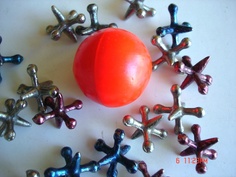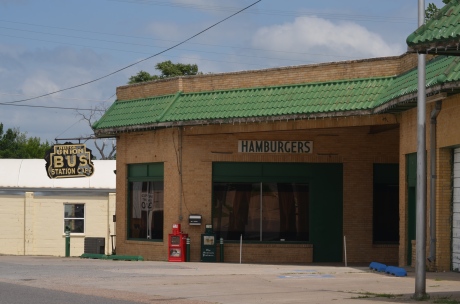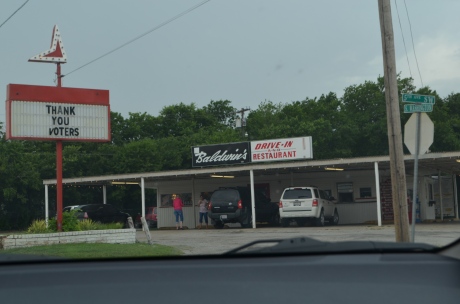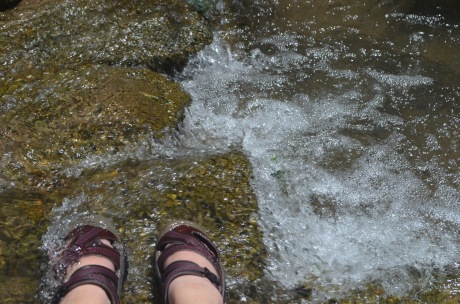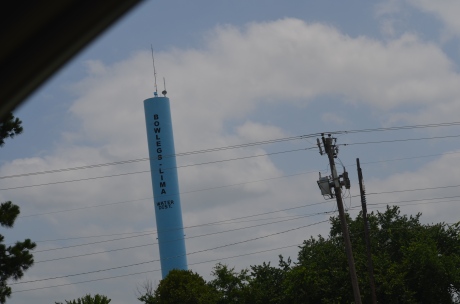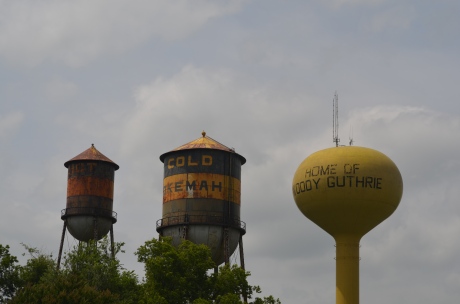Mark Twain and Laura Ingalls Wilder lived in Missouri. He was born there, she died there. They both wrote fiction based on their childhood. Last week I visited both of their homes and came home with a renewed fascination with these two remarkable people.
I had been to Hannibal 15 years ago with my son. He was working with an improv comedy group in college and I told him he needed to learn more about one of the greatest stand up comedians, Mark Twain. We spent an afternoon in Hannibal, listening to Hal Holbrook’s tape on the way back to school, a couple of hours away.
Nothing much had changed at Mark Twain’s boyhood home since I had been there, which is a good thing. The night we arrived, I sat on a bench at twilight in front of his home and looked down the street at the Mississippi River while I ate huckleberry ice cream. It seemed like the perfect way to start the visit. The white picket fence had a bucket with brushes tied to it so you could take your picture while pretending to whitewash the famous fence. Last time I visited, the fence had extended further, but they’ve built a lovely garden on what was an empty lot.
 The house is well preserved. I saw pictures around town of Mark Twain standing in front of the house on his last visit to Hannibal in 1902. He’d come a long way from his days as young Sam Clemens. My favorite picture was of the photographers and reporters taking pictures of him as he visited, while young boys and townspeople looked on. He was a rock star in his time.
The house is well preserved. I saw pictures around town of Mark Twain standing in front of the house on his last visit to Hannibal in 1902. He’d come a long way from his days as young Sam Clemens. My favorite picture was of the photographers and reporters taking pictures of him as he visited, while young boys and townspeople looked on. He was a rock star in his time. I had strolled up and down the streets and the river, taking it all in once again. The mighty Mississippi that I first learned about through his books spread out before me. The hill where Tom and Huck played to my left, the building where young Clemens first worked for a printer in front of me, his father’s courtroom beside me.
I had strolled up and down the streets and the river, taking it all in once again. The mighty Mississippi that I first learned about through his books spread out before me. The hill where Tom and Huck played to my left, the building where young Clemens first worked for a printer in front of me, his father’s courtroom beside me.
In the morning, I took the tour of the house again, picking out the window he climbed out, as described in Tom Sawyer. Before you go through the house, there is a nice interpretive center that gives a timeline of his life and gives the background on what in his books is taken from his life, which people he used for the characters.
We visited the other museum downtown with its nice interactive area that would appeal to children and its collection of first editions and copies of Twain’s books in many languages. My favorite is the collection of the Norman Rockwell paintings that were the illustrations for one of the reprints of Tom Sawyer and Huckleberry Finn. What a match of two great artists with their sense of humor and small town living. I only wish they also had some of the originals of another Missouri artist who illustrated the books at another time, Thomas Hart Benton.
This trip, I took the riverboat cruise to get the feel of being on the Mississippi. It’s a strong, wide body of water and there is a peace about floating along its waters. I must admit that I was thinking of kids on rafts being in the middle of this current. I shook my head at the dangers. Later, I captured a photo of this little town on the river from Lovers Leap bluff with the riverboat coming in and a train rolling by. I could live easily with the sound of the boats and the trains.  Before I left town, I looked up the street towards the statue of Tom and Huck, the first statue dedicated to fictional characters in the United States, and the hill where Sam Clemens played. Even with the hardships his family endured, his childhood was idyllic in his memory. I took a graduate level class on Twain in college, but my travels through the places he wrote about, Hannibal, Virginia City, San Francisco, and more, bring him to life just as he brought those places to life for all those who delight in his writing.
Before I left town, I looked up the street towards the statue of Tom and Huck, the first statue dedicated to fictional characters in the United States, and the hill where Sam Clemens played. Even with the hardships his family endured, his childhood was idyllic in his memory. I took a graduate level class on Twain in college, but my travels through the places he wrote about, Hannibal, Virginia City, San Francisco, and more, bring him to life just as he brought those places to life for all those who delight in his writing.
On my way home from this trip to Missouri and Kentucky, I found that we would pass by Mansfield, MO, where the Laura Ingalls Wilder home and museum are located. I came to her books later in life when my oldest daughter was reading them. I picked one up, read the whole series and searched for more. I found a biography of what her real life was like, much harsher than the books in childhood. Mansfield is where she and her husband, Almanzo, her precious Manley as she called him, and her remarkable daughter, Rose, settled. Once again, the museum was a delight, filled with so many actual items from their lives along with a timeline of both Laura and Rose’s lives.  The family that got out of the van next to our car in the parking lot looked like they had stepped out of Laura’s time, but they were Amish, a family paying tribute. Other little girls scampered around the grounds, wearing sunbonnets and long dresses, playing Laura from the books and television series.
The family that got out of the van next to our car in the parking lot looked like they had stepped out of Laura’s time, but they were Amish, a family paying tribute. Other little girls scampered around the grounds, wearing sunbonnets and long dresses, playing Laura from the books and television series. I was reminded that Laura didn’t start writing the books until she was 65, when the stock market crash had wiped Laura and Almanzo out of their investments in their retirement. Then she wrote one about every two years, writing into her 80s. Once again, the museum helped sort out fact from the written memoirs, bringing new dimensions to the stories. And I gained new knowledge and appreciation for the accomplishments of the remarkable Rose Wilder Lane, Laura and Almanzo’s only surviving child, herself a renowned author, journalist, and political activist.
I was reminded that Laura didn’t start writing the books until she was 65, when the stock market crash had wiped Laura and Almanzo out of their investments in their retirement. Then she wrote one about every two years, writing into her 80s. Once again, the museum helped sort out fact from the written memoirs, bringing new dimensions to the stories. And I gained new knowledge and appreciation for the accomplishments of the remarkable Rose Wilder Lane, Laura and Almanzo’s only surviving child, herself a renowned author, journalist, and political activist.
Our guide through the farm house and the little rock house that Rose built for her parents was a delight, an older woman who had actually known Laura and brought so much life to the tours. She was all that I love about small towns and Missourians with her openness, friendliness and sense of humor. I love the fact that Almanzo built the entire farmhouse in stages, using materials from the farm, taking 18 years to complete it. I love that the counters and cabinets in the kitchen were designed for his small wife, who was only 4’11”. He was only 5’4″, so everything was to scale. No wonder she was nicknamed “Half Pint” by her Pa. He built much of the furniture, including chairs that were low to the ground. I felt I knew Laura after seeing her favorite collections of china and the things she treasured around her, including her beloved library. I love the fact that she only got a refrigerator a year before she died. We take such things for granted. It’s typical that Rose bought the refrigerator, always wanting to bring her parents into the modern world.  The little rock house that was a Christmas gift from Rose to her parents was built from a Sears & Roebuck plan using rocks from the property, supervised by Almanzo. This is the house where Laura actually wrote her first four books in the Little House series, marching up the hill to the farmhouse to discuss them with Rose, who helped with editing and shaping these stories for publication.
The little rock house that was a Christmas gift from Rose to her parents was built from a Sears & Roebuck plan using rocks from the property, supervised by Almanzo. This is the house where Laura actually wrote her first four books in the Little House series, marching up the hill to the farmhouse to discuss them with Rose, who helped with editing and shaping these stories for publication.  I would love to have listened to these two strong willed women argue over the drafts of the books, each fighting for one change or another. And Almanzo, walking with his cane since his stroke early in their marriage, walked down the rock stairs to the field below to milk the goats and carry the milk to the other end of the field to store in the spring house. I also love that Rose bought them a car in 1923 and they loved it, using it to take trips to California and Minnesota and nearby Springfield whenever they felt like getting out. Almanzo and Laura were the true story of how our country grew.
I would love to have listened to these two strong willed women argue over the drafts of the books, each fighting for one change or another. And Almanzo, walking with his cane since his stroke early in their marriage, walked down the rock stairs to the field below to milk the goats and carry the milk to the other end of the field to store in the spring house. I also love that Rose bought them a car in 1923 and they loved it, using it to take trips to California and Minnesota and nearby Springfield whenever they felt like getting out. Almanzo and Laura were the true story of how our country grew. 
I hadn’t planned to visit both places when I left home, but they made nice bookends to the trip. Two of my favorites when I read their works and even more beloved now that I can see them in their homes and know so much more about them as real people who looked back on their childhoods, discarded the worst memories and transformed the best into stories that continue to inspire readers of all ages today, teaching us about the strength of human nature, the joy in relationships, and the humor in mankind. Classics in every sense of the word.
 You approach the arch and look out to the Mississippi River.
You approach the arch and look out to the Mississippi River. Entering the pods to go to the top of the arch is like being in a sci-fi movie…
Entering the pods to go to the top of the arch is like being in a sci-fi movie… …but the view from the top is 30 miles in each direction.
…but the view from the top is 30 miles in each direction. The arch is glorious in all lights and weather.
The arch is glorious in all lights and weather. The history of St. Louis is intertwined with the expansion of our country west with the Mississippi River an important part.
The history of St. Louis is intertwined with the expansion of our country west with the Mississippi River an important part. From the old LaClere’s Landing, the neighborhoods expand westward, each a piece in the map of history. The Hill had been recommended to us as a “must go to” place for Italian food. This area developed around the Italian immigrants who mined the hills.
From the old LaClere’s Landing, the neighborhoods expand westward, each a piece in the map of history. The Hill had been recommended to us as a “must go to” place for Italian food. This area developed around the Italian immigrants who mined the hills. Today it is a wonderful neighborhood of extreme pride and an Italian restaurant on just about every block, sometimes on every corner of an intersection.
Today it is a wonderful neighborhood of extreme pride and an Italian restaurant on just about every block, sometimes on every corner of an intersection.  I tried to find out which ones were the best and they all got great reviews. We settled on this one for a lunch of toasted ravioli, a local favorite.
I tried to find out which ones were the best and they all got great reviews. We settled on this one for a lunch of toasted ravioli, a local favorite.
 Yummy! We left the neighborhood with its Bocce Club
Yummy! We left the neighborhood with its Bocce Club and drove around the city with all its diversity. There are the French homes around Lafayette Square
and drove around the city with all its diversity. There are the French homes around Lafayette Square and brick homes around the city that matched my image of St. Louis from before I arrived. Downtown is the wonderful old train station, now a hotel…
and brick homes around the city that matched my image of St. Louis from before I arrived. Downtown is the wonderful old train station, now a hotel… and the beautiful areas around the University of St. Louis where this old standpipe at the Compton Hill Reservoir rose above us as we drove.
and the beautiful areas around the University of St. Louis where this old standpipe at the Compton Hill Reservoir rose above us as we drove. Driving around, there were so many signs of the city that tell some of its story, like this one from the days when it was sometimes referred to as Mound City for the many ancient Native American mounds in the area,
Driving around, there were so many signs of the city that tell some of its story, like this one from the days when it was sometimes referred to as Mound City for the many ancient Native American mounds in the area, or this old bath house. We know there were at least six of them.
or this old bath house. We know there were at least six of them. Or this Farmer’s Market sign. That’s an OLD business…
Or this Farmer’s Market sign. That’s an OLD business… I can’t leave out the food and drink that are St. Louis traditions, starting with the beers…
I can’t leave out the food and drink that are St. Louis traditions, starting with the beers… with the gargoyles on the building across from the iconic Anheiser Busch structures.
with the gargoyles on the building across from the iconic Anheiser Busch structures.
 There are Ted Drewe’s famous custard shoppes with frozen custard called the “concrete” because you can turn it upside down and your spoon won’t fall out…
There are Ted Drewe’s famous custard shoppes with frozen custard called the “concrete” because you can turn it upside down and your spoon won’t fall out… and ooey gooey butter cakes. This one was ranked #1 in St. Louis for the past six years. I attest to its deliciousness.
and ooey gooey butter cakes. This one was ranked #1 in St. Louis for the past six years. I attest to its deliciousness.
 We ate some St. Louis BarBQue in the old industrial area. Their most popular item was Snoots (pig snouts). While I stood there, every call was for snoots. They’re kind of like pork rinds, crispy. I figured I HAD to try them. How bad could they be if everyone was ordering them? They were good.
We ate some St. Louis BarBQue in the old industrial area. Their most popular item was Snoots (pig snouts). While I stood there, every call was for snoots. They’re kind of like pork rinds, crispy. I figured I HAD to try them. How bad could they be if everyone was ordering them? They were good.  I passed this bottle sign every day, situated at a busy place near Rams stadium. I liked everything about it.
I passed this bottle sign every day, situated at a busy place near Rams stadium. I liked everything about it. We ended our day with a baseball game, watching the St. Louis Cardinals. I’d grown up listening to the games on the radio. The new stadium is great, easy to get around, the crowd friendly and relaxed.
We ended our day with a baseball game, watching the St. Louis Cardinals. I’d grown up listening to the games on the radio. The new stadium is great, easy to get around, the crowd friendly and relaxed.  From the stadium, you can see the Arch, a few blocks away, always framing the city.
From the stadium, you can see the Arch, a few blocks away, always framing the city. St Louis is celebrating its 250th birthday this year. Decorated birthday cakes are in front of businesses around town in support of this momentous occasion. There is so much more to see and do in St. Louis, but I’m happy I got to enjoy the birthday party. It’s an intriguing, entertaining city.
St Louis is celebrating its 250th birthday this year. Decorated birthday cakes are in front of businesses around town in support of this momentous occasion. There is so much more to see and do in St. Louis, but I’m happy I got to enjoy the birthday party. It’s an intriguing, entertaining city.























